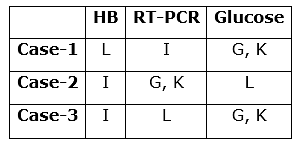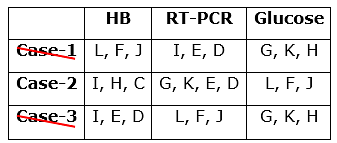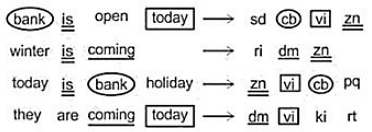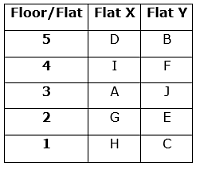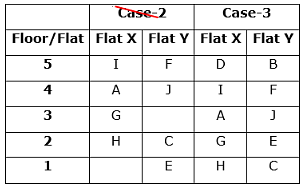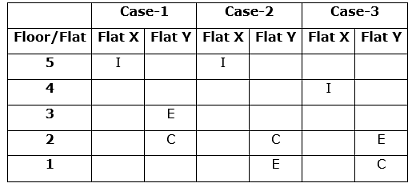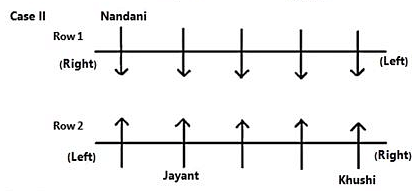IBPS RRB PO (Scale 1) Prelims Mock Test - 6 - Banking Exams MCQ
30 Questions MCQ Test - IBPS RRB PO (Scale 1) Prelims Mock Test - 6
Direction: The following questions are based on the three-digit numbers given below. Study the information carefully and answer the questions.
483 396 625 834 967
If in the above set of numbers 1 is added to the last digit and 2 is subtracted from first digit, then which number will be third if arranged in descending order?
Direction: The following questions are based on the three-digit numbers given below. Study the information carefully and answer the questions.
483 396 625 834 967
If in each number first and third digits are interchanged, then how many even numbers are there?
| 1 Crore+ students have signed up on EduRev. Have you? Download the App |
Direction: The following questions are based on the three-digit numbers given below. Study the information carefully and answer the questions.
483 396 625 834 967
If 2 is added to the last digit of each number and then the positions of the first and the second digits are interchanged, which of the following will be the highest number?
Direction: The following questions are based on the three-digit numbers given below. Study the information carefully and answer the questions.
483 396 625 834 967
If each number is multiplied by 2, then what is the multiplication of the first digit of the lowest and last digit of the largest number?
Direction: The following questions are based on the three-digit numbers given below. Study the information carefully and answer the questions.
483 396 625 834 967
What will be the number obtained if third digit of the smallest number is multiplied with second digit of the second largest number?
Study the following information carefully and answer the questions given below.
Ten persons C, D, E, F, G, H, I, J, K and L are taking three different tests in the laboratory viz. HB, RT-PCR, and Glucose test, but not necessarily in the same order. At least three persons but not more than four persons are taking the same test.
I neither takes the glucose test nor takes the test along with K. G takes the test along with K, who doesn’t take the HB test. L takes the test along with neither I nor G. E takes the test along with D but none of them takes glucose test. Neither L nor H takes the test along with D. H doesn’t take the RT-PCR test. Both L and H take different tests. F takes the test along with J. Neither J nor G takes the test along with C, who doesn’t take the test along with E.
Who among the following person takes HB test?
Study the following information carefully and answer the questions given below.
Ten persons C, D, E, F, G, H, I, J, K and L are taking three different tests in the laboratory viz. HB, RT-PCR, and Glucose test, but not necessarily in the same order. At least three persons but not more than four persons are taking the same test.
I neither takes the glucose test nor takes the test along with K. G takes the test along with K, who doesn’t take the HB test. L takes the test along with neither I nor G. E takes the test along with D but none of them takes glucose test. Neither L nor H takes the test along with D. H doesn’t take the RT-PCR test. Both L and H take different tests. F takes the test along with J. Neither J nor G takes the test along with C, who doesn’t take the test along with E.
Which of the following statement(s) is/are true with respect to the final arrangement?
I. Both H and I take the Glucose test
II. Neither K nor G takes the RT-PCR test
III. D takes the test along with G
Study the following information carefully and answer the questions given below.
Ten persons C, D, E, F, G, H, I, J, K and L are taking three different tests in the laboratory viz. HB, RT-PCR, and Glucose test, but not necessarily in the same order. At least three persons but not more than four persons are taking the same test.
I neither takes the glucose test nor takes the test along with K. G takes the test along with K, who doesn’t take the HB test. L takes the test along with neither I nor G. E takes the test along with D but none of them takes glucose test. Neither L nor H takes the test along with D. H doesn’t take the RT-PCR test. Both L and H take different tests. F takes the test along with J. Neither J nor G takes the test along with C, who doesn’t take the test along with E.
Four of the following five are alike in a certain way as per the given arrangement and hence form a group. Find the one who does not belong to that group?
Study the following information carefully and answer the questions given below.
Ten persons C, D, E, F, G, H, I, J, K and L are taking three different tests in the laboratory viz. HB, RT-PCR, and Glucose test, but not necessarily in the same order. At least three persons but not more than four persons are taking the same test.
I neither takes the glucose test nor takes the test along with K. G takes the test along with K, who doesn’t take the HB test. L takes the test along with neither I nor G. E takes the test along with D but none of them takes glucose test. Neither L nor H takes the test along with D. H doesn’t take the RT-PCR test. Both L and H take different tests. F takes the test along with J. Neither J nor G takes the test along with C, who doesn’t take the test along with E.
If all the persons are made to take the test in the alphabetical order and the tests are HB, RT-PCR and Glucose respectively, with thesame number of persons as before, then how many persons remain unchanged in their position?
Study the following information carefully and answer the questions given below.
Ten persons C, D, E, F, G, H, I, J, K and L are taking three different tests in the laboratory viz. HB, RT-PCR, and Glucose test, but not necessarily in the same order. At least three persons but not more than four persons are taking the same test.
I neither takes the glucose test nor takes the test along with K. G takes the test along with K, who doesn’t take the HB test. L takes the test along with neither I nor G. E takes the test along with D but none of them takes glucose test. Neither L nor H takes the test along with D. H doesn’t take the RT-PCR test. Both L and H take different tests. F takes the test along with J. Neither J nor G takes the test along with C, who doesn’t take the test along with E.
Who among the following person take the test along with C?
Direction: Study the following information and answer the given question:
12 people belong to different countries: India, China, Japan, Russia, France, Germany, Italy, Iran, Spain, Israel, America and Australia. are seated in two parallel rows with six people in each row such that there is equal distance between the adjacent persons and each person in one row faces the person in another row. In row 1, Rinky, Pinky, Raju, Tony, Nisha, and Nil are seated facing South and in row 2, Deepa, Ajay, Rina, Tina, Mina and Shyam are seated facing North not necessarily in the same order. Two persons sits between Raju and the one who belongs to Iran. Neither of them sits at the extreme ends of the row. The one who faces Raju is an immediate neighbour of Tina who belongs to France. Tina does not sit at the end of the row. Deepa sits second to the left of Tina. Deepa faces the one who belongs to Germany. Nil who belongs to Japan sits in front of the one who belongs to Spain. The one who belongs to Spain is not an immediate neighbour of Tina. The one who belongs to China sits second to the right of Ajay. Nisha belongs to India and does not sits in front of Tina. Rinky is not an immediate neighbour of Nisha. Tony sits in front of Mina who belongs to Russia. Shyam does not belongs to Spain. Neither Pinky nor Ajay belongs to Italy and America. The one who belongs to Italy does not sit at any of the extreme ends of the row. Ajay does not belong to Australia.
Who is sitting in front of Shyam?
Direction: Study the following information and answer the given question:
12 people belong to different countries: India, China, Japan, Russia, France, Germany, Italy, Iran, Spain, Israel, America and Australia. are seated in two parallel rows with six people in each row such that there is equal distance between the adjacent persons and each person in one row faces the person in another row. In row 1, Rinky, Pinky, Raju, Tony, Nisha, and Nil are seated facing South and in row 2, Deepa, Ajay, Rina, Tina, Mina and Shyam are seated facing North not necessarily in the same order. Two persons sits between Raju and the one who belongs to Iran. Neither of them sits at the extreme ends of the row. The one who faces Raju is an immediate neighbour of Tina who belongs to France. Tina does not sit at the end of the row. Deepa sits second to the left of Tina. Deepa faces the one who belongs to Germany. Nil who belongs to Japan sits in front of the one who belongs to Spain. The one who belongs to Spain is not an immediate neighbour of Tina. The one who belongs to China sits second to the right of Ajay. Nisha belongs to India and does not sits in front of Tina. Rinky is not an immediate neighbour of Nisha. Tony sits in front of Mina who belongs to Russia. Shyam does not belongs to Spain. Neither Pinky nor Ajay belongs to Italy and America. The one who belongs to Italy does not sit at any of the extreme ends of the row. Ajay does not belong to Australia.
Who belongs to Australia?
Direction: Study the following information and answer the given question:
12 people belong to different countries: India, China, Japan, Russia, France, Germany, Italy, Iran, Spain, Israel, America and Australia. are seated in two parallel rows with six people in each row such that there is equal distance between the adjacent persons and each person in one row faces the person in another row. In row 1, Rinky, Pinky, Raju, Tony, Nisha, and Nil are seated facing South and in row 2, Deepa, Ajay, Rina, Tina, Mina and Shyam are seated facing North not necessarily in the same order. Two persons sits between Raju and the one who belongs to Iran. Neither of them sits at the extreme ends of the row. The one who faces Raju is an immediate neighbour of Tina who belongs to France. Tina does not sit at the end of the row. Deepa sits second to the left of Tina. Deepa faces the one who belongs to Germany. Nil who belongs to Japan sits in front of the one who belongs to Spain. The one who belongs to Spain is not an immediate neighbour of Tina. The one who belongs to China sits second to the right of Ajay. Nisha belongs to India and does not sits in front of Tina. Rinky is not an immediate neighbour of Nisha. Tony sits in front of Mina who belongs to Russia. Shyam does not belongs to Spain. Neither Pinky nor Ajay belongs to Italy and America. The one who belongs to Italy does not sit at any of the extreme ends of the row. Ajay does not belong to Australia.
Who is sitting between Tina and Deepa?
Direction: Study the following information and answer the given question:
12 people belong to different countries: India, China, Japan, Russia, France, Germany, Italy, Iran, Spain, Israel, America and Australia. are seated in two parallel rows with six people in each row such that there is equal distance between the adjacent persons and each person in one row faces the person in another row. In row 1, Rinky, Pinky, Raju, Tony, Nisha, and Nil are seated facing South and in row 2, Deepa, Ajay, Rina, Tina, Mina and Shyam are seated facing North not necessarily in the same order. Two persons sits between Raju and the one who belongs to Iran. Neither of them sits at the extreme ends of the row. The one who faces Raju is an immediate neighbour of Tina who belongs to France. Tina does not sit at the end of the row. Deepa sits second to the left of Tina. Deepa faces the one who belongs to Germany. Nil who belongs to Japan sits in front of the one who belongs to Spain. The one who belongs to Spain is not an immediate neighbour of Tina. The one who belongs to China sits second to the right of Ajay. Nisha belongs to India and does not sits in front of Tina. Rinky is not an immediate neighbour of Nisha. Tony sits in front of Mina who belongs to Russia. Shyam does not belongs to Spain. Neither Pinky nor Ajay belongs to Italy and America. The one who belongs to Italy does not sit at any of the extreme ends of the row. Ajay does not belong to Australia.
Which country does Rina belongs to?
Direction: Study the following information and answer the given question:
12 people belong to different countries: India, China, Japan, Russia, France, Germany, Italy, Iran, Spain, Israel, America and Australia. are seated in two parallel rows with six people in each row such that there is equal distance between the adjacent persons and each person in one row faces the person in another row. In row 1, Rinky, Pinky, Raju, Tony, Nisha, and Nil are seated facing South and in row 2, Deepa, Ajay, Rina, Tina, Mina and Shyam are seated facing North not necessarily in the same order. Two persons sits between Raju and the one who belongs to Iran. Neither of them sits at the extreme ends of the row. The one who faces Raju is an immediate neighbour of Tina who belongs to France. Tina does not sit at the end of the row. Deepa sits second to the left of Tina. Deepa faces the one who belongs to Germany. Nil who belongs to Japan sits in front of the one who belongs to Spain. The one who belongs to Spain is not an immediate neighbour of Tina. The one who belongs to China sits second to the right of Ajay. Nisha belongs to India and does not sits in front of Tina. Rinky is not an immediate neighbour of Nisha. Tony sits in front of Mina who belongs to Russia. Shyam does not belongs to Spain. Neither Pinky nor Ajay belongs to Italy and America. The one who belongs to Italy does not sit at any of the extreme ends of the row. Ajay does not belong to Australia.
Which of the following condition is true?
In the given question, the relationship between different elements is shown in the statements followed by some conclusions. Find the conclusion which is definitely true.
Given answers:
a) Only conclusion I is true
b) Only conclusion II is true
c) Either conclusion I or II is true
d) Neither conclusion I nor II is true
e) Both conclusions I and II are true
Statements:
Y ≥ F > J > U; B < R ≤ F < K; B ≥ W = D
Conclusions:
I. D < R
II. K ≤ Y
In the given question, the relationship between different elements is shown in the statements followed by some conclusions. Find the conclusion which is definitely true.
Given answers:
a) Only conclusion I is true
b) Only conclusion II is true
c) Either conclusion I or II is true
d) Neither conclusion I nor II is true
e) Both conclusions I and II are true
Statements:
H ≥ W = S ≥ G < K; E < J = G ≥ O > I; R > J ≥ Y
Conclusions:
I. I < K
II. Y ≤ H
In the given question, the relationship between different elements is shown in the statements followed by some conclusions. Find the conclusion which is definitely true.
Given answers:
a) Only conclusion I is true
b) Only conclusion II is true
c) Either conclusion I or II is true
d) Neither conclusion I nor II is true
e) Both conclusions I and II are true
Statements:
A ≥ T > G; S < J < E ≤ G; S > Q = I
Conclusions:
I. A > I
II. Q < E
In the given question, the relationship between different elements is shown in the statements followed by some conclusions. Find the conclusion which is definitely true.
Given answers:
a) Only conclusion I is true
b) Only conclusion II is true
c) Either conclusion I or II is true
d) Neither conclusion I nor II is true
e) Both conclusions I and II are true
Statements:
Q > N = I; T ≥ Q > L; I ≤ Z < P
Conclusions:
I. N ≤ P
II. I < T
Direction: Study the following information carefully and answer the given questions.
In a certain code language, ‘bank is open today’ is written as ‘sd cb vi zn’, ‘winter is coming’ is written as ‘ri dm zn’, ‘today is bank holiday’ is written as ‘zn vi cb pq’, and ‘they are coming today’ is written as ‘dm vi ki rt’.
Code ‘vi zn sd ri’ is for which of the following sentence in the given language?
Direction: Study the following information carefully and answer the given questions.
In a certain code language, ‘bank is open today’ is written as ‘sd cb vi zn’, ‘winter is coming’ is written as ‘ri dm zn’, ‘today is bank holiday’ is written as ‘zn vi cb pq’, and ‘they are coming today’ is written as ‘dm vi ki rt’.
What is a code of ‘bank’?
Direction: Study the following information carefully and answer the given questions.
In a certain code language, ‘bank is open today’ is written as ‘sd cb vi zn’, ‘winter is coming’ is written as ‘ri dm zn’, ‘today is bank holiday’ is written as ‘zn vi cb pq’, and ‘they are coming today’ is written as ‘dm vi ki rt’.
Code ‘pq’ is for which word in the given language?
Study the following information carefully and answer the questions given below.
Ten persons A, B, C, D, E, F, G, H, I and J are living in two different flats viz. Flat X and Flat Y of a five-storey building but not necessarily in the same order. Flat X is to the west of Flat Y. The lowermost floor is numbered as 1 and the floor immediately above the lowermost floor is numbered as 2 and so on.
I lives three floors above C, where both of them live in different flats. E lives southeast of I, both are not living on adjacent floors. The number of floors above E is the same as the number of floors below F. A lives immediately below F but does not live in the same flat as E. H lives two floors below A. J lives Northeast of G, who doesn’t live below C. Both D and B live above J, where D doesn’t live in the same flat as J.
Who among the following person lives on the floor which is immediately above the floor on which E lives?
Study the following information carefully and answer the questions given below.
Ten persons A, B, C, D, E, F, G, H, I and J are living in two different flats viz. Flat X and Flat Y of a five-storey building but not necessarily in the same order. Flat X is to the west of Flat Y. The lowermost floor is numbered as 1 and the floor immediately above the lowermost floor is numbered as 2 and so on.
I lives three floors above C, where both of them live in different flats. E lives southeast of I, both are not living on adjacent floors. The number of floors above E is the same as the number of floors below F. A lives immediately below F but does not live in the same flat as E. H lives two floors below A. J lives Northeast of G, who doesn’t live below C. Both D and B live above J, where D doesn’t live in the same flat as J.
Who among the following person lives on floor 4 of Flat Y?
Study the following information carefully and answer the questions given below.
Ten persons A, B, C, D, E, F, G, H, I and J are living in two different flats viz. Flat X and Flat Y of a five-storey building but not necessarily in the same order. Flat X is to the west of Flat Y. The lowermost floor is numbered as 1 and the floor immediately above the lowermost floor is numbered as 2 and so on.
I lives three floors above C, where both of them live in different flats. E lives southeast of I, both are not living on adjacent floors. The number of floors above E is the same as the number of floors below F. A lives immediately below F but does not live in the same flat as E. H lives two floors below A. J lives Northeast of G, who doesn’t live below C. Both D and B live above J, where D doesn’t live in the same flat as J.
If A is related to B and H is related to J in a certain way, then who among the following person is related to F?
Study the following information carefully and answer the questions given below.
Ten persons A, B, C, D, E, F, G, H, I and J are living in two different flats viz. Flat X and Flat Y of a five-storey building but not necessarily in the same order. Flat X is to the west of Flat Y. The lowermost floor is numbered as 1 and the floor immediately above the lowermost floor is numbered as 2 and so on.
I lives three floors above C, where both of them live in different flats. E lives southeast of I, both are not living on adjacent floors. The number of floors above E is the same as the number of floors below F. A lives immediately below F but does not live in the same flat as E. H lives two floors below A. J lives Northeast of G, who doesn’t live below C. Both D and B live above J, where D doesn’t live in the same flat as J.
How many floors are there between D and C?
Study the following information carefully and answer the questions given below.
Ten persons A, B, C, D, E, F, G, H, I and J are living in two different flats viz. Flat X and Flat Y of a five-storey building but not necessarily in the same order. Flat X is to the west of Flat Y. The lowermost floor is numbered as 1 and the floor immediately above the lowermost floor is numbered as 2 and so on.
I lives three floors above C, where both of them live in different flats. E lives southeast of I, both are not living on adjacent floors. The number of floors above E is the same as the number of floors below F. A lives immediately below F but does not live in the same flat as E. H lives two floors below A. J lives Northeast of G, who doesn’t live below C. Both D and B live above J, where D doesn’t live in the same flat as J.
Four of the following five are alike in a certain way as per the given arrangement and hence form a group. Find the one who does not belong to that group.
Direction: Study the following information carefully and answer the questions given below:
Ten persons are sitting in two parallel rows containing five persons each, in such a way that there is an equal distance between adjacent persons. In first row Nandani, Abhinav, Shekhar, Shalu, and Namita are seated and all of them are facing south. In second row, Khushi, Aaryan, Divy, Jayant, and Raghav are seated and all of them are facing north. Therefore in the given seating arrangement each member seated in a row faces another member of the other row. Jayant sits third to the left of Khushi. Nandani faces immediate neighbour of Jayant. Shekhar sits second to the right of Nandani. Only one person sits between Abhinav and Shalu. Aaryan and Raghav are immediate neighbours. Raghav does not face Nandani and Abhinav.
Which of the following is true regarding Aaryan?
Direction: Study the following information carefully and answer the questions given below:
Ten persons are sitting in two parallel rows containing five persons each, in such a way that there is an equal distance between adjacent persons. In first row Nandani, Abhinav, Shekhar, Shalu, and Namita are seated and all of them are facing south. In second row, Khushi, Aaryan, Divy, Jayant, and Raghav are seated and all of them are facing north. Therefore in the given seating arrangement each member seated in a row faces another member of the other row. Jayant sits third to the left of Khushi. Nandani faces immediate neighbour of Jayant. Shekhar sits second to the right of Nandani. Only one person sits between Abhinav and Shalu. Aaryan and Raghav are immediate neighbours. Raghav does not face Nandani and Abhinav.
Four of the following five are alike in a certain way and thus form a group. Which is the one that does not belong to that group?
Direction: Study the following information carefully and answer the questions given below:
Ten persons are sitting in two parallel rows containing five persons each, in such a way that there is an equal distance between adjacent persons. In first row Nandani, Abhinav, Shekhar, Shalu, and Namita are seated and all of them are facing south. In second row, Khushi, Aaryan, Divy, Jayant, and Raghav are seated and all of them are facing north. Therefore in the given seating arrangement each member seated in a row faces another member of the other row. Jayant sits third to the left of Khushi. Nandani faces immediate neighbour of Jayant. Shekhar sits second to the right of Nandani. Only one person sits between Abhinav and Shalu. Aaryan and Raghav are immediate neighbours. Raghav does not face Nandani and Abhinav.
Who amongst the following faces Shalu?















